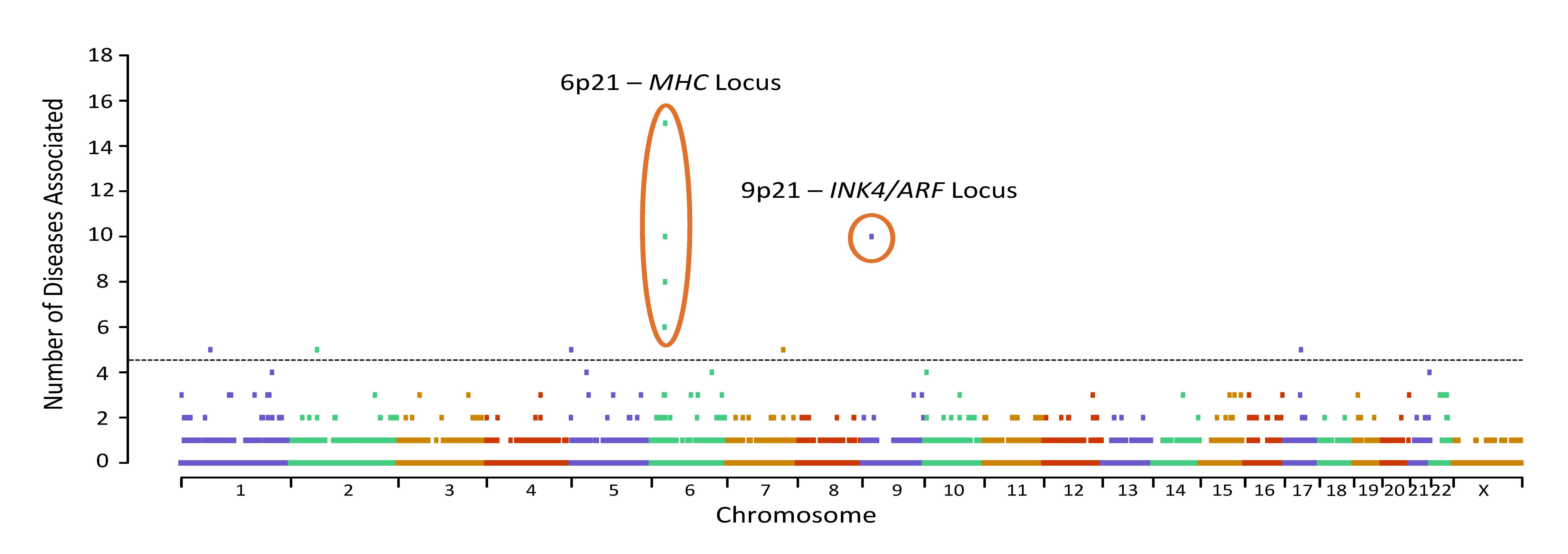Chapel Hill, NC –Researchers have long known that individual diseases are associated with genes in specific locations of the genome.
Genetics researchers at the University of North Carolina at Chapel Hill now have shown definitively that a small number of places in the human genome are associated with a large number and variety of diseases. In particular, several diseases of aging are associated with a locus which is more famous for its role in preventing cancer.
For this analysis, researchers at UNC Lineberger Comprehensive Cancer Center catalogued results from several hundred human Genome-Wide Association Studies (GWAS) from the National Human Genome Research Institute. These results provided an unbiased means to determine if varied different diseases mapped to common ‘hotspot’ regions of the human genome. This analysis showed that two different genomic locations are associated with two major subcategories of human disease.

“Our team is interested in understanding genetic susceptibility to diseases associated with aging, including cancer,” said PhD student William Jeck, who was first author on the study, published in the journal Aging Cell.
The team examined the large NHGRI dataset and first eliminated hereditable traits such as eye or hair color and other non-disease traits like drug metabolism. The group then focused on variants identified from GWAS that contributed to actual diseases. Combining results from all of these studies, there was enough data to arrive at statistically valid conclusions. The team then mapped the disease associations to the appropriate locations of the genome, counting the number of unique diseases mapping to specific genomic regions, in order to see if disparate diseases mapped randomly throughout the genome, or clustered in hotspots.
“What we ended up with is a very interesting distribution of disease risk across the genome. More than 90 percent of the genome lacked any disease loci. Surprisingly, however, lots of diseases mapped to two specific loci, which soared above all of the others in terms of multi-disease risk. The first locus at chromosome 6p21, is where the major histocompatibility (MHC) locus resides. The MHC is critical for tissue typing for organ and bone marrow transplantation, and was known to be an important disease risk locus before genome-wide studies were available. Genes at this locus determine susceptibility to a wide variety of autoimmune diseases such as arthritis, celiac disease, Type I diabetes, asthma, psoriasis, and lupus,” said Jeck.
“The second place where disease associations clustered is the INK4/ARF (or CDKN2a) tumor suppressor locus. This area, in particular, was the location for diseases associated with aging: atherosclerosis, heart attacks, stroke, Type II diabetes, glaucoma and various cancers.” he added.
“The finding that INK4/ARF is associated with lots of cancer, and MHC is associated with lots of diseases of immunity is not surprising—these associations were known. What is surprising is the diversity of diseases mapping to just two small places: 30 percent of all tested human diseases mapped to one of these two places. This means that genotypes at these loci determine a substantial fraction of a person’s resistance or susceptibility to multiple independent diseases,” said Ned Sharpless, MD, Wellcome Distinguished Professor of Cancer Research and Associate Director of Translational Research at UNC Lineberger.
Another interesting finding was the apparent role of two biological processes in multi-disease association. In addition to the MHC and INK4/ARF loci, five less significant hotspot loci were also identified. Of the seven total hotspot loci, however, all contained genes associated with either immunity or cellular senescence. Cellular senescence is a permanent form of cellular growth arrest, and it is an important means whereby normal cells are prevented from becoming cancerous. It has been long known that senescent cells accumulate with aging, and may cause aspects of aging. This new analysis provides evidence that genetic differences in an individual’s ability to regulate the immune response and activate cellular senescence determine their susceptibility to many seemingly disparate diseases.
“We call the absence of disease ‘wellness’, and our results suggest the genetics of wellness may be much more simple than previously suspected. Put another way, these unbiased data from about two million people suggest that your eccentric Uncle Joe, who drank and smoked, but who also lived to be 110 and was never sick a day in his life—well Uncle Joe may have just been genetically fortunate at a couple of loci,” said Sharpless.
Alex Siebold, PhD also worked on the research team. The study was supported by the Burroughs Wellcome Fund and the National Institute of Aging (AG024379).
